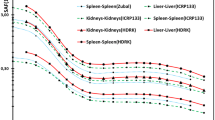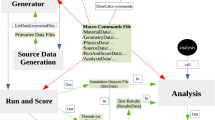Abstract
It is of great interest to estimate absorbed doses in organs before radiation therapy, especially in nuclear medicine field. In this regard, the internal dose distribution is required. According to the MIRD formalism, Specific Absorbed Fraction (SAF) is an essential parameter for internal dosimetry. In the present work, SAF values for the voxelized phantom (Golem) of the GSF-National Research Center for Environment and Health were calculated using Geant4/GATE with Standard packages and compared with GSF Monte Carlo reference data. Photon irradiations of 30, 100 keV and 1 MeV energy were simulated in eleven different sources and target organs: liver, kidneys, lungs, brain, pancreas, spleen, colon, Red bone marrow (RBM), stomach, thyroid and adrenals. The SAF for self-absorption and for cross-irradiation to other organs were calculated and compared with literature. The results agree with published data, with an average relative difference less than 3%, for the self-absorption of 100 keV and 1 MeV photon energies. The agreement of Geant4/GATE and GSF code might depend on the distance between target and source, the target mass and the photons energy. Generally, the present results indicate that GATE might be used with gamma emitters for internal dosimetry in regard to our prospective works.
Similar content being viewed by others
References
D. L. Bailey, A. van Aswegen, et al., Nuclear Medicine Physics: A Handbook for Teachers and Students (International Atomic Energy Agency, Vienna, 2014).
International Commission on Radiological Protection, Radiation Dose to Patients from Radiopharmaceuticals (Pergamon, Oxford, UK, 1987).
W. S. Snyder et al., “Estimates of absorbed fractions for monoenergetic photon sources uniformly distributed in various organs of a heterogeneous phantom,” J. Nucl. Med. 10, 7–52 (1969).
H. Zaidi and X. G. Xu, “Computational anthropomorphic models of the human anatomy: The path to realistic Monte Carlo modeling in radiological sciences,” Annu. Rev. Biomed. Eng. 9, 471–500 (2007).
I. G. Zubal, C.R. Harrell, E. O. Smith, et al., “Computerized three-dimensional segmented human anatomy,” Med. Phys. 21 (2), 299–302 (1994).
X. G. Xu et al., “VIP-MAN: An image-based wholebody adult male model constructed from color photographs of the Visible Human Project for multi-particle Monte Carlo calculations,” Health Phys. 78, 476–486 (2000).
N. Petoußsi-Henß et al., “Voxel or MIRD-type model: A sensitivity study relevant to nuclear medicine,” in IFMBE Proceedings (Springer, 2007), Vol. 14, pp. 2061–2064.
Geant4 Collaboration. www.geant4.cern.ch. 2010.
S. Jan, G. Santin, D. Strul, et al., “GATE (Geant4 Application for Tomographic Emission): A simulation toolkit for PET and SPECT,” Phys. Med. Biol. 49, 4543–4561 (2004).
A. A. Parach, H. Rajabi, M. A. Askari, et al., “Assessment of MIRD data for internal dosimetry using the GATE Monte Carlo code,” Radiat. Environ. Biophys. 50, 441–450 (), (2011).
Y. Perrot et al., “Internal dosimetry through GATE simulations of preclinical radiotherapy using a melanintargeting ligand,” Phys. Med. Biol. 59, 2183–2198 (2014).
M. Zankl and A. Wittmann, “The adult male voxel model ‘Golem’ segmented from whole-body CT patient data,” Radiat. Environ. Biophys. 40, 153–162 (2001).
N. Petoußsi-Henß and M. Zankl, “Voxel anthropomorphic models as a tool for internal dosimetry,” Radiat. Prot. Dosim. 79, 415–418 (1998).
M. Zankl et al., “Assessment of body doses from photon exposures using human voxel models,” (in Proc. 10th Int. Congress of the International Radiation Protection Association, Hiroshima, Japan, 2000).
D. Sarrut, M. Bardiès, N. Boussion, N. Freud, S. Jan, J.-M. Létang, et al., “A review of the use and potential of the GATE Monte Carlo simulation code for radiation therapy and dosimetry applications,” Med. Phys. 41, (064301), (2014).
R. Veit et al., Tomographic Anthropomorphic Models, Part I: Construction Technique and Description of Models of an 8 Week Old Baby and a 7 Year Old Child (Gesellschaft für Strahlen- und Umweltforschung, München, 1989).
Author information
Authors and Affiliations
Corresponding author
Additional information
The article is published in the original.
About this article
Cite this article
Kaddouch, S., El Khayati, N. Geant4/GATE Monte Carlo Code for Internal Dosimetry Using Voxelized Phantom. Moscow Univ. Phys. 72, 658–662 (2017). https://doi.org/10.3103/S0027134918660062
Received:
Published:
Issue Date:
DOI: https://doi.org/10.3103/S0027134918660062




